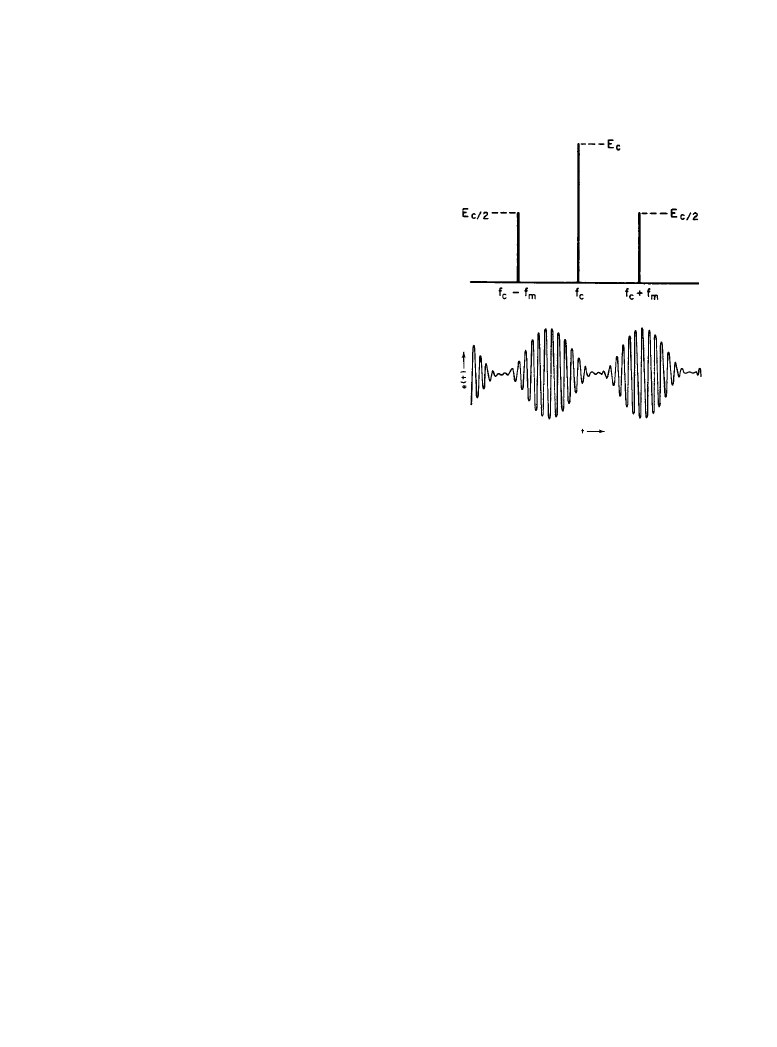ВУЗ: Казахская Национальная Академия Искусств им. Т. Жургенова
Категория: Книга
Дисциплина: Не указана
Добавлен: 03.02.2019
Просмотров: 21675
Скачиваний: 19

11-47
Chapter
11.3
Radio Broadcasting
Jerry C. Whitaker, Editor-in-Chief
11.3.1 Introduction
Standard broadcasting refers to the transmission of voice and music received by the general pub-
lic in the 535–1705 kHz frequency band. Amplitude modulation is used to provide service rang-
ing from that needed for small communities to higher powered broadcast stations needed for
larger regional areas. The primary service area is defined as the area in which the ground or sur-
face-wave signal is not subject to objectionable interference or objectionable fading. The second-
ary service area refers to an area serviced by skywaves and not subject to objectionable
interference. Intermittent service area refers to an area receiving service from either a surface
wave or a skywave but beyond the primary service area and subject to some interference and fad-
ing.
11.3.2 Standard Broadcasting
The carrier frequencies for standard broadcasting in the U.S. (referred to internationally as
medium wave broadcasting) are designated in the Federal Communications Commission (FCC)
Rules and Regulations. A total of 117 carrier frequencies are allocated from 540 to 1700 kHz in
10-kHz intervals. Each carrier frequency is required by the FCC rules to deviate no more than
±20 Hz from the allocated frequency to minimize heterodyning from two or more interfering sta-
tions.
11.3.2a
Modulation Techniques
Double-sideband full-carrier modulation, commonly called amplitude modulation (AM), is used
in standard broadcasting for sound transmission. Basically, the amplitude of an analog radio fre-
quency (RF) carrier is controlled by an analog audio frequency (AF) modulating signal. The
resulting RF waveform consists of a carrier wave plus two additional signals that are the result of
the modulation process: an upper-sideband signal, which is equal in frequency to the carrier plus
the audio modulating frequency, and a lower-sideband signal, which equals the carrier frequency
minus the audio modulating frequency.
Downloaded from Digital Engineering Library @ McGraw-Hill (www.digitalengineeringlibrary.com)
Copyright © 2004 The McGraw-Hill Companies. All rights reserved.
Any use is subject to the Terms of Use as given at the website.
Source: Standard Handbook of Audio and Radio Engineering

11-48 Broadcast Transmission Systems
Modulation of the AM Carrier Wave
Figure 11.3.1 shows a fully amplitude modulated signal. When the peak value of the modulated
carrier wave (produced by a positive excursion of the audio modulating signal) is twice the value
of the unmodulated carrier, and the minimum value of the RF carrier reaches zero (produced by
a negative excursion of the modulating signal), 100 percent modulation occurs. If the transmitter
is well designed, with sufficient headroom, it is possible to exceed 100 percent positive modula-
tion with an asymmetrical waveform, but the negative modulation may never exceed 100 percent
(the RF carrier at zero or completely cut off) without causing distortion of the demodulated sig-
nal. The power contained in the audio sidebands created in the process of modulating the carrier
100 percent is equal to 25 percent of the carrier power in both the upper and lower sidebands. As
a result, the overall power transmitted during periods of 100 percent modulation is 150 percent of
the unmodulated carrier power. (See Figure 11.3.2.)
The overall bandwidth is equal to twice the highest audio modulating frequency. Although
full fidelity is possible with amplitude modulation, the FCC requires standard broadcast stations
to limit the fidelity, thus restricting occupied bandwidth of the transmitted signal. Typical modu-
lation frequencies for voice and music range from 50 Hz to 10 kHz. Each channel is generally
thought of as 10 kHz in width, and thus the frequency band is designated from 535 to 1705 kHz;
however, when the modulation frequency exceeds 5 kHz, the radio frequency bandwidth of the
channel exceeds 10 kHz and adjacent channel interference may occur.
Stations may also utilize advanced modulation techniques to enhance the transmitted infor-
mation. Quadrature modulation of the AM carrier is utilized a large number of AM stations to
transmit stereophonic programming (separate left and right audio channels). The FCC standard
for AM stereo modulation does not cause interference in conventional envelope detector receiv-
ers. In addition, the system complies with FCC occupied bandwidth limitations, and all interna-
tional agreements. New, more advanced modulation techniques have successfully been tested
allowing for transmission of stereo sound to listeners, free of the static bursts caused by impulse
noise. Such systems allow AM stations to transmit digital programming simultaneously, and on
Figure 11.3.1
Double-sideband amplitude modulation.
Figure 11.3.2
An amplitude-modulated waveform.
Downloaded from Digital Engineering Library @ McGraw-Hill (www.digitalengineeringlibrary.com)
Copyright © 2004 The McGraw-Hill Companies. All rights reserved.
Any use is subject to the Terms of Use as given at the website.
Radio Broadcasting

Radio Broadcasting 11-49
the same channel, with their analog programming. The result is an analog component that is
compatible with existing receivers, and a separate digital component offering high-quality stereo
audio.
11.3.2b
Channel and Station Classifications
In standard broadcast (AM), stations in the U.S. are classified by the FCC according to their
operating power, protection from interference, and hours of operation. A Class A station operates
with 10 to 50 kW of power servicing a large area with primary, secondary, and intermittent cov-
erage and is protected from interference both day and night. These stations are called clear chan-
nel stations because the channel is cleared of nighttime interference over a major portion of the
country. Class B stations operate full time with transmitter powers of 0.25 to 50 kW and are
designed to render primary service only over a principal center of population and contiguous
rural area. Whereas nearly all Class A stations operate with 50 kW, most Class B stations must
restrict their power to 5 kW or less to avoid interfering with other stations. Class B stations oper-
ating in the 1605 to 1705 kHz band are restricted to a power level of 10 kW daytime and 1 kW
nighttime. Class C stations operate on six designated channels (1230, 1240, 1340, 1400, 1450,
and 1490) with a maximum power of 1 kW or less full time and render primarily local service to
smaller communities. Class D stations operate on Class A or B frequencies with Class B trans-
mitter powers during daytime, but nighttime operation—if permitted at all—must be at low
power (less than 0.25 kW) with no protection from interference.
When a station is already limited by interference from other stations to a contour of higher
value than that normally protected for its class, this higher-value contour is the established pro-
tection standard for the station.
Although Class A stations cover large areas at night (approximately a 1000 km radius), the
nighttime coverage of Class B, C, and D stations is limited by interference from other stations,
electrical devices, and atmospheric conditions to a relatively small area. Class C stations, for
example, have an interference-free nighttime coverage radius of approximately 8 to 16 km. As a
result there may be large differences in the area that the station covers daytime vs. nighttime.
With thousands of AM stations licensed for operation by the FCC, interference, both day and
night, is a factor that significantly limits the service stations can provide. In the absence of inter-
ference, a daytime signal strength of 2 mV/m is required for reception in populated towns and
cities, whereas a signal of 0.5 mV/m is generally acceptable in rural areas without large amounts
of man-made interference present. Secondary nighttime service is provided in areas receiving a
0.5-mV/m signal 50 percent or more of the time without objectionable interference. However, it
should be noted that these limits apply to new stations and modifications to existing stations.
Nearly every station on the air was allocated prior to the implementation of these rules with
interference criteria that were less restrictive.
11.3.2c
Field Strength
The field strength produced by a standard broadcast station is a key factor in determining the pri-
mary and secondary service areas and interference limitations of possible future radio stations.
The FCC and others have conducted significant testing to determine what levels of interference
are acceptable from adjacent and co-channel stations and have used that data in determining how
close stations can be located to one another. If the transmitted power, antenna radiation charac-
Downloaded from Digital Engineering Library @ McGraw-Hill (www.digitalengineeringlibrary.com)
Copyright © 2004 The McGraw-Hill Companies. All rights reserved.
Any use is subject to the Terms of Use as given at the website.
Radio Broadcasting

11-50 Broadcast Transmission Systems
teristics, and ground conductivity are known, the extent of coverage (or interference) in a given
direction for a particular station can be calculated with a high degree of accuracy. These calcula-
tions form the basis of the FCC's station allocation system and are based on field intensities with
the unit of measure as volts per meter (the voltage induced in an antenna 1 m in length).
11.3.2d
Propagation
One of the major factors in the determination of field strength is the propagation characteristic,
described as the change in electric field intensity with an increase in distance from the broadcast
station antenna. This variation depends on a number of factors including frequency, distance,
surface dielectric constant, surface loss tangent, polarization, local topography, and time of day.
Generally speaking, surface-wave propagation occurs over shorter ranges both during day and
night periods. Skywave propagation in the AM broadcast band permits longer ranges and occurs
during night periods, and thus some stations must either reduce power or cease to operate at night
to avoid causing interference. Skywave propagation is much less predictable than surface-wave
propagation, because it necessarily involves some fading and less predictable field intensities
and is most appropriately described in terms of statistics or the percentage of time a particular
field strength level is found.
11.3.2e Transmitters
Standard AM broadcast transmitters range in power output from 5 W up to 50 kW units. Modern
transmitters utilize low-voltage, high-current metal-oxide-semiconductor field-effect transistor
(MOSFET) devices to generate the RF power. However, in a high-power transmitter, it may take
hundreds of transistors to generate the rated power. These transistors are combined into modules,
the outputs of which are combined to produce the output signal. This design approach has the
added benefit that in the event of a module failure, the transmitter continues to operate, but at
slightly reduced power.
High-Level AM Modulation
High-level anode modulation is the oldest and simplest way of generating a high power AM sig-
nal. In this system, the modulating signal is amplified and combined with the de supply source to
the anode of the final RF amplifier stage. The RF amplifier is normally operated class C. The
final stage of the modulator usually consists of a pair of tubes operating class B. A basic modula-
tor of this type is shown in Figure 11.3.3.
The RF signal is normally generated in a low-level transistorized oscillator. It is then ampli-
fied by one or more solid-state or vacuum-tube stages to provide final RF drive at the appropriate
frequency to the grid of the final class C amplifier. The audio input is applied to an intermediate
power amplifier (usually solid state) and used to drive two class B (or class AB) push-pull output
stages. The final amplifiers provide the necessary modulating power to drive the final RF stage.
For 100 percent modulation, this modulating power is 50 percent of the actual carrier power.
The modulation transformer shown in Figure 11.3.3 does not usually carry the dc supply cur-
rent for the final RF amplifier. The modulation reactor and capacitor shown provide a means to
combine the audio signal voltage from the modulator with the dc supply to the final RF ampli-
fier. This arrangement eliminates the necessity of having dc current flow through the secondary
of the modulation transformer, which would result in magnetic losses and saturation effects. In
Downloaded from Digital Engineering Library @ McGraw-Hill (www.digitalengineeringlibrary.com)
Copyright © 2004 The McGraw-Hill Companies. All rights reserved.
Any use is subject to the Terms of Use as given at the website.
Radio Broadcasting

Radio Broadcasting 11-51
some transmitter designs, the modulation reactor is eliminated from the system, thanks to
improvements in transformer technology.
The RF amplifier normally operates class C with grid current drawn during positive peaks of
the cycle. Typical stage efficiency is 75 to 83 percent.
This type of system was popular in AM broadcasting for many years, primarily because of its
simplicity. The primary drawback is low overall system efficiency. The class B modulator tubes
cannot operate with greater than 50 percent efficiency. Still, with inexpensive electricity, this was
not considered to be a significant problem. As energy costs increased, however, more efficient
methods of generating high-power AM signals were developed. Increased efficiency normally
came at the expense of added technical complexity.
Pulse-Width Modulation
Pulse-width (also known as pulse-duration) modulation is one of the most popular systems
developed for modern vacuum-tube AM transmitters. Figure 11.3.4 shows a scheme for pulse-
width modulation identified as PDM (as patented by the Harris Corporation). The PDM system
works by utilizing a square wave switching system, illustrated in Fig. 11.3.5.
The PDM process begins with a signal generator (Figure 11.3.6). A 75-kHz sine wave is pro-
duced by an oscillator and used to drive a square wave generator, resulting in a simple 75-kHz
square wave. The square wave is then integrated, resulting in a triangular waveform, which is
mixed with the input audio in a summing circuit. The result is a triangular waveform that effec-
Figure 11.3.3
Basic configuration for high-level amplitude modulation in the standard broadcast
band.
Downloaded from Digital Engineering Library @ McGraw-Hill (www.digitalengineeringlibrary.com)
Copyright © 2004 The McGraw-Hill Companies. All rights reserved.
Any use is subject to the Terms of Use as given at the website.
Radio Broadcasting